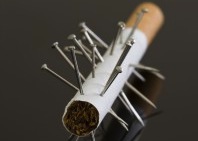
Despite being on the decline, smoking is still one of the largest causes of preventable morbidity and mortality in the world. According to recent World Health Organisation data, smoking directly kills around 5 million people every year. The NHS spends almost £90 million on cessation efforts to combat the £5 billion treatment cost. Recent research (expertly summarized by Dr Paul Christiansen for the Mental Elf here) suggests quitting smoking is the easy part, however maintaining abstinence is much more difficult.
One of the main barriers to smoking cessation is the experience of withdrawal symptoms. These symptoms, although temporary, can cause distress and impair daily functioning. Indeed, the experience of these symptoms is thought to directly undermine smoking cessation efforts and predict relapse.
Acupuncture is a traditional Chinese therapy which uses fine needles inserted through the skin at specific points. These needles may be stimulated by hand or with an electric current, known as electro-acupuncture, in order to precisely stimulate the release of neurotransmitters that may be involved in the suppression of withdrawal symptoms. Similar therapies including laser therapy, electrical stimulation and acupressure are also used as smoking cessation aids. The aim of these techniques is to reduce the experience of withdrawal symptoms.
Uncontrolled studies demonstrate high rates of success for acupuncture and related therapies, with a reduction in nicotine withdrawal, however lack of control suggests this may be little more than a placebo effect.
A recent Cochrane Review (White et al, 2014) set out to determine the effectiveness of acupuncture and related interventions for smoking cessation.
Methods
The authors searched the Cochrane Tobacco Addiction Group Specialized Register for all randomised controlled trials comparing acupuncture, acupressure, laser therapy or electro-stimulation with either no intervention, sham intervention or another intervention for smoking cessation to examine whether:
- They were more effective than waiting list intervention
- Have a specific effect beyond placebo
- Are more effective than other smoking cessation interventions such as nicotine replacement therapy (NRT) or counselling
They identified 38 studies qualifying for inclusion: 23 using acupuncture, 5 using acupressure, 3 using laser stimulation and 7 using electrostimulation. The main outcome measure was complete abstinence from smoking. Studies were not limited to biochemical confirmation of cessation.
Results
- For long-term abstinence, acupuncture was not shown to be more effective than a waiting list control (RR = 1.79, 95% CIs 0.98 to 3.28)
- When comparing active acupuncture against sham acupuncture, there was evidence of a small-short term benefit immediately after the intervention (RR = 1.22, 95% CIs 1.08 to 1.38). However there was no long term benefit (RR = 1.10, 95% CIs 0.86 to 1.40)
- Acupressure was also more effective than sham acupressure in the short term (RR = 2.54, 95% CIs 1.27 to 5.08). However, no data was available for long-term outcomes.
- Acupuncture was less effective than nicotine replacement therapy both in the short term (RR = 0.76, 95% CIs 0.59 to 0.98) and in the long-term (RR = 0.64, 95% CIs 0.42 to 0.98)
- In comparison to counselling and psychological approaches to smoking cession, acupuncture showed no differential effects at either short (RR = 0.95, 95% CIs 0.72 to 1.26) or long term follow-ups (RR = 1.34, 95% CIs 0.80 to 2.24)
- Data for electrostimulation demonstrated no beneficial effects compared to sham electrostimulation at short or long term follow-ups, and the limited data for laser therapy (2 studies) showed considerable heterogeneity and could not be analysed

The Cochrane review found no consistent evidence that active acupuncture had any clear benefits on smoking cessation
Discussion
The Cochrane review found no consistent evidence that active acupuncture had any clear benefits on smoking cessation. The authors suggest that the evidence for acupuncture’s effectiveness and efficacy is inconsistent. These results support current NICE guidelines which do not recommend acupuncture as a treatment for smoking cessation (NICE, 2008).
The authors also highlight various problems contributing to the inconsistencies in the findings:
- First, there were high rates of heterogeneity between the studies which could not totally be explained by the acupuncture methods used
- Second, the authors noted a risk of bias in a variety of studies included in the meta-analysis, with two studies suggesting efficacy of acupuncture in the long term having a high risk of bias
- Finally, the authors demonstrated larger studies were more likely to show no effect, which suggests the possibility of publication bias.
To conclude the authors suggest:
There is no bias-free, consistent evidence that acupuncture, acupressure, laser therapy, or electrostimulation are effective interventions for smoking cessation
further supporting the evidence that acupuncture is little more than a theatrical placebo.

Many individuals find acupuncture useful in giving up smoking, but the evidence shows that this benefit comes from the placebo effect
Links
White AR, Rampes H, Liu JP, Stead LF, Campbell J. Acupuncture and related interventions for smoking cessation. Cochrane Database of Systematic Reviews 2014, Issue 1. Art. No.: CD000009. DOI: 10.1002/14651858.CD000009.pub4.
Smoking cessation services in primary care, pharmacies, local authorities and workplaces, particularly for manual working groups, pregnant women and hard to reach communities (PDF). NICE Public Health guidance 10, Feb 2008.


Cochrane review finds that acupuncture, acupressure, laser therapy and electrostimulation show little benefit … http://t.co/yow4sOKtDc
Mental Elf: Cochrane review finds that acupuncture, acupressure, laser therapy and electrostimulation show little… http://t.co/mkLiemJmqU
Acupuncture, Acupressure, Laser Therapy & Electrostimulation show little benefit for #SmokingCessation http://t.co/n6jVESn7fl
Nog maar eens bevestigd: acupunctuur helpt niet om te stoppen met roken: http://t.co/19BXnnw7wz
“Acupuncture is little more than a theatrical placebo” @ajj_1988 on #Acupuncture & #SmokingCessation http://t.co/n6jVESn7fl
@Mental_Elf – All healing is Self healing.I offer a complimentary get acquainted call if u want to explore- http://t.co/5CbtwPttq5
Cochrane review finds that acupuncture, acupressure, laser therapy and electrostimulation show… http://t.co/kZ6mWeNjaN
My latest @Mental_Elf blog on #acupunture and related therapies for #smoking http://t.co/wpRvVLX10a …. they show little benefit!
New @CochraneTAG review of #acupuncture for #smoking cessation shows no consistent evidence of benefit http://t.co/n6jVESn7fl
Acupuncture, acupressure, laser therapy and electrostimulation show little benefit for smoking cessation http://t.co/MKx4WW3E5e
Current @NICEcomms guidelines do not recommend acupuncture as a treatment for smoking cessation http://t.co/n6jVESn7fl
@Mental_Elf @NICEcomms Good!
#Acupuncture for #smoking cessation? Trendy but lacking in evidence, says @Mental_Elf, based on a Cochrane review. http://t.co/8xitrjYM34
@DavidGratzer @Mental_Elf I tried it to help with hypertension. They just stuck needles in me, left me alone and charged £50. No change.
@TheBAcC What do you think of the recent Cochrane review of acupuncture for smoking cessation? http://t.co/n6jVESn7fl
Nice review. Lest anyone get confused, most practitioners and many patients can identify sham acupuncture vs the “real thing” and so blinding is imperfect. Besides who will buy “ancient Chinese wisdom” as an adequate scientific mechanism?
Don’t miss: Cochrane review finds that acupuncture & related interventions show little benefit for smoking cessation http://t.co/n6jVESn7fl
“@Mental_Elf: Cochrane review finds that acupuncture & related interventions show little benefit http://t.co/ULL4Y1qukm” @EBPatUWE
@Mental_Elf good choice of review…well done!